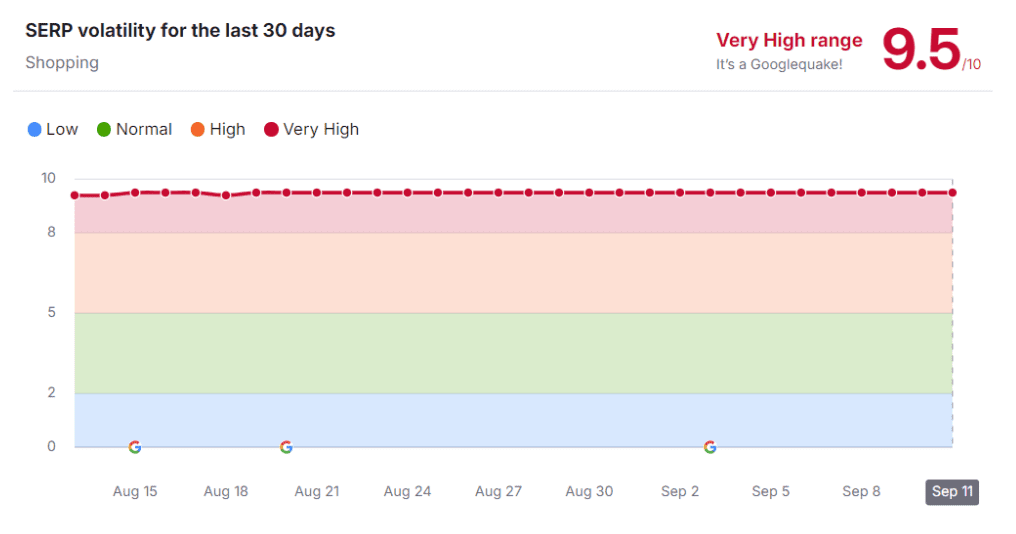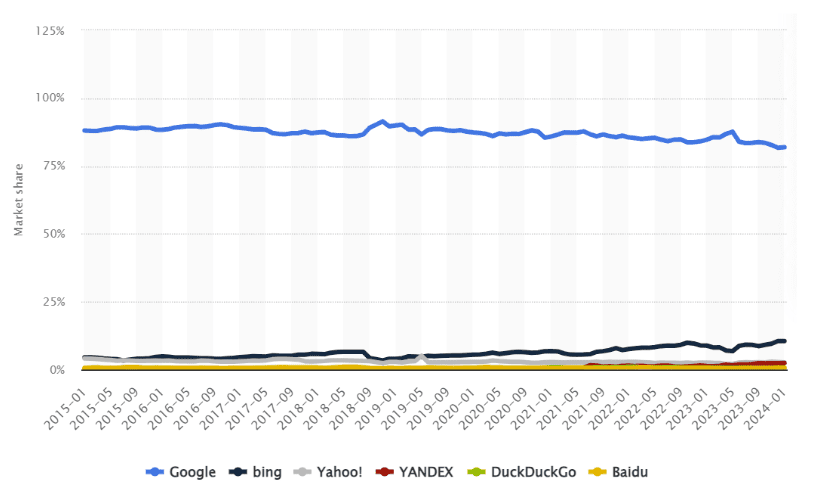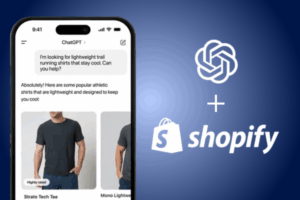The state of SEO for ecommerce in 2024 looks different in October than it did in January. Anyone who works in SEO can tell you things are constantly changing. High volatility in the search engine results pages (SERPs) has become the new normal. What worked last year may not work this year, and what didn’t work last year… well, it probably still doesn’t work today. It can be hard to keep up, but that’s what your ROI Revolution SEO team lives for. Continue reading for what you need to know about SEO in 2024.
- Algorithm Updates
- KPIs beyond SERP position
- Helpful Content
- Generative AI
- Technical SEO
- Do Backlinks Matter Anymore?
- SEO Beyond Google
- A Few Last Thoughts
Algorithm Updates
So far, we’ve only had two core algorithm updates this year from Google. The March 2024 core update was impressive – taking 45 days to fully roll out. With that one, Google incorporated the Helpful Content System into the core algorithm, and many site owners and publishers complained they were unfairly penalized. Google provided a feedback form and used that feedback to tweak the core algorithm with the August update. For more information on Google updates, read Google Algorithm Updates: History & Latest Changes.
In March and June, Google also updated its spam algorithms, demoting websites that broke its rules regarding fraudulent and potentially harmful practices. While it was hard to tell how much of a difference the March spam update made because it coincided with the March algo update, the June update had an impact on visibility for many sites that were not directly affected by it. Many of our clients’ websites saw a lift in visibility as the spammier sites were demoted or removed from the SERPs.
In the last year, Google also stopped releasing big reviews-system updates in favor of ongoing tweaks (smaller scale changes that aren’t officially announced as algorithm updates) to that system. This change might be a contributing factor to the nearly constant high volatility in the SERPs. It feels like “high” has become the new average when looking at the SEO sensors from tools like SEMrush.

KPIs Beyond SERP Position
Many SEOs have traditionally considered Google rankings their key performance indicators (KPIs) because higher positions used to mean more visibility in the SERPs and more traffic to their website. Unfortunately, with all the extra features Google has added to results pages in recent years, like free shopping ads, AI Overviews, Things to Know, etc., even ranking in the first organic position on Google means users may need to scroll to see you. Your keyword rankings might be excellent, but your year-over-year visibility could be much lower.
The latest data from Advanced Web Rankings shows:
- In Q2 of this year, branded searches saw an overall decline in clicks.
- While search demand increased for a wide range of topics, clicks through the top one and two positions on mobile devices stayed the same or declined for many of them.
- Sports, business, education, and hobbies and interests saw increased clicks in the top two positions on desktop, but other industries typically saw fewer.
Chasing rankings and feeling like your big successes make little difference when you enter the top three is deflating. Instead of using rankings as a KPI, consider what is truly important to the growth of your business. Is it new customer acquisition? More revenue? A higher conversion rate? How can you drive more qualified customers to your site, rather than just trying to capture as many impressions as possible with position one?
If traffic is your goal, impressions and clicks are fine, but if revenue is your goal, qualified traffic is more important. There’s a difference. Qualified traffic may mean fewer clicks, but with the help of good CRO practices, you should see more revenue resulting from the clicks you earn. To find that qualified traffic, you need to provide high-quality content that matches your audience’s needs. Why attract readers who won’t become customers?
Helpful Content Still Rules
The question of qualified traffic leads us to the focus on helpful content. The old days of writing blog posts based on what’s trending or which keywords have the highest search volume, regardless of how tangential the topic, are gone. While trends and volume are still important, writing content to capture Google’s attention rather than to help potential customers on their shopping journey is an ineffective use of time.
Instead, focus on your entities, which are pieces of information (typically people, things, or concepts) related to your business. Entities help Google understand your topical authority. Your content should be directly related to your business model, and it should work to make the connections between your entities and your business for Google. That way, when someone searches for something that your company excels in, Google understands that you should be at the top of the list.
Helpful content is more than just well-written page copy; user experience has become more prominent in the conversation. Once a user lands on your website from an organic link, their next step should be clear. If they made an informational query, your content should answer that question clearly and concisely. If they want to make a purchase, your product listing pages and product detail pages should make it easy for them to find what they are looking for and hit that “add to cart” or “buy now” button.
Clean up those pages to make them as obviously transactional as possible. Move the products to the top. Answer questions they may have about the items or services and move the more editorial and informational content to the bottom, or link to it on a separate page. Not only will doing this help the user become a customer, but it will also help Google understand the purpose of the page.
In the Google Search Console screenshot below, you can see an example of a product listing page that was hit by the Helpful Content Updates last fall and saw a steady decline after Google decided the page was too confusing to show for transactional queries because informational content was at the top of the page and the products were at the bottom. Once the product listings were moved to the top, making it clear that the purpose of the page was to sell them, the page saw almost immediate improvement.

Generative AI
Generative AI is possibly the most controversial topic in SEO this year. It has been disruptive in the SERPs, detrimental when used recklessly, and – at the same time – a great tool when used well.
AI Overviews
When Google first introduced AI Overviews, the real-world version of the Search Generative Experience lab, it caused shock, awe, and quite a bit of laughter. From ridiculous answers, like a recommendation to use glue to keep the cheese on your pizza from slipping, to potentially dangerous answers to Your Money Your Life (YMYL) questions, people took to social media to let Google know how they felt.
After quite a bit of tweaking, AI Overviews now behave much like Featured Snippets. When they are served, both show at the top of the SERP, link to the websites they are sourced from, and could result in zero clicks (but also could result in a click through to the source). If you earn an AI Overview now, it suggests that Google trusts your website as an authority, which means you’re doing something right for your E-E-A-T (expertise, experience, authoritativeness, and trustworthiness).
Even so, searchers who are just looking for easy answers will likely be satisfied with what they’re shown on the SERP and will not click through. Those who do click will be better-qualified traffic. Ensure those landing pages are optimized for user intent, so once they land on the page, they have every reason to stay and convert.
Programmatic SEO
With the growing use of generative AI for everything from brainstorming creative ideas to answering Excel spreadsheet conundrums, it’s no surprise that many website owners have seen it as a way to accelerate content and page creation on their sites. Google’s official stance is that using generative AI is okay, as long as it’s not to game search engines … but of course, using it to create content at scale for the purpose of showing up more often in the SERPs is gaming search engines. Earlier this year, our team wrote a blog post explaining the potential pitfalls of this practice, and our advice still holds up: don’t do it without extreme caution (and advice from your ROI SEO team).
Double Down on Being Human
Using generative AI in the writing process can be a time-saving shortcut, but you must understand how the tools work. At this point, generative AI isn’t really that intelligent; it’s more like your phone’s predictive text on steroids. The models are fed data from sources across the internet, they make connections between words based on probabilities, and then they spit out the most likely words to follow each other in a string. That may be an oversimplification, but you can see the point.
We’ve tested the big models at ROI Revolution, and we have seen two of three, given the exact same prompt, provide almost the exact same answer. The third was different enough to show that its training data was not the same, but the content it provided was still very basic. This leads to the question: If the models all provide average content with little variation and everyone uses the models to write content, where does that leave the reader? Unsatisfied.
This is where you have the chance to shine! Take what the models give you and then look at the subject like the human you are. What else do you need to know? How can you add personal experience to the content? (You know – that second E in E-E-A-T?)
If your article is instructions for doing something, what would your reader need to know that a language model wouldn’t include? Maybe they need to have clean towels on hand because the automotive project is usually messier than an instruction manual would let on. Or you can warn your readers about the ick factor that comes with cleaning a drain clog. How about the physical symptoms from potential side effects of immunotherapy and how to manage them?
The models may have the language, but they don’t have the emotion. Double down on being human to ensure your content stands above the rest.
Technical SEO
Technical SEO matters as much now as ever. This includes site speed/Core Web Vitals, crawlability and ease of indexing, and appropriate tags to keep Google from indexing what you don’t want shown on the SERPs. If Google indexes a page meant for employees with a log-in, and a user lands there and bounces quickly, Google might suspect a site quality issue over its own error in showing the page. Avoid that by noindexing that page.
Images and Video
Google improved its Lens for search experience by adding the ability to add text to your image query. Users can also circle to search, which allows them to show Google what part of the image they want to focus on. There are a few things you can do to improve your website’s chances of showing for an image search:
- Create clean images of your product from multiple angles.
- Use lifestyle imagery, as long as it’s clear that your product is the focus of the picture.
- Ensure your images have unique, descriptive alt text.
- Make the images mobile friendly.
For more information on optimizing your images for SEO, read our Image Attributes blog post.
To have your videos and video watch pages rank for video search, the video content on the page needs to be the main piece of content in an obvious way. Place it at the top of the page and limit what else is shown. Ensure the word “video” is used in your video page’s URL and title. You should also use schema markup to ensure Google understands the focus of the page.
Interstitial Usage
Intrusive interstitials are still on Google’s naughty list, so if you’re using one to capture emails, you must decide which is more important to your business: rankings or email sign-ups. If the number of email signups you receive isn’t moving the needle, you may want to capture them another way or, at the very least, make your pop-up smaller and delayed, so it’s less offensive to Googlebot.
Do Backlinks Matter Anymore?
Backlinks are still important, and the focus has been on quality over quantity for years now. Still, it’s becoming harder to gain those links. Digital PR must be part of your plan for gaining high-quality backlinks.
Google has figured out how to measure user engagement and understand user sentiment, and it will reward or downgrade your rankings accordingly. Here are some pointers for the new way to think about backlinks:
- Stay in your lane. Writing interesting articles just for the purpose of attracting links won’t help, unless the articles are truly helpful to your users. Show a deep knowledge of the main focus of your website rather than a shallow understanding of a variety of tangential topics, or worse, unrelated topics.
- Don’t concern yourself with toxic backlinks. Many of the popular SEO tools will sound the alarm and highlight the number of spammy links to your website. In the past, these were problematic, but Google’s systems have advanced to the point where they can ignore them completely. So, unless someone in your company has intentionally purchased backlinks, they can be low on your priority list. You can read more about this in our August 2024 SEO News Recap.
- In the June edition of Google’s SEO Office Hours, Gary Illyes told the audience to only worry about broken backlinks “if they would be helpful to your users.” Trying to fix all the broken backlinks on a large site could be a lot of effort for a little payoff.
Within your website, you’ll want to keep internal and external links useful to the reader, so they move smoothly on their customer journey.
SEO Beyond Google
SEO extends beyond Google. Don’t get us wrong; Google still gets more than the lion’s share of traffic, but with the recent federal court ruling against the tech giant and slight gains by other search engines, optimizing for those search engines makes sense. Those alternatives include Bing, Duck Duck Go, and YouTube. Newcomers like Perplexity must be watched, too. Typically, the rules that work for Google also work for the others, but you should keep in mind that they are all unique.
The graph below from Statista shows Bing is making bigger gains in market share than the others, while Google has seen a slight decline. Bing incorporated generative AI into its search product before Google did, which sparked its bigger improvement compared to the competition.

Note: Worldwide usage; does not include newcomer Perplexity
We’re also watching generational changes. Gen Z audiences are using social media platforms like TikTok as search engines more than their older counterparts. The good news is you can repurpose your web content for these platforms to get in front of younger searchers.
Keep in mind that SEO extends beyond Google, in part because building your brand outside of Google will help on Google, too. The more widely recognized your brand name is on other channels – from social media to connected TV, other online spaces, and even offline – the more likely someone will search for your brand when they start looking for products or services like yours.
A Few Last Thoughts on SEO Trends in 2024
SEO works best as part of a holistic approach to digital marketing – organic, paid social, feeds, conversion rate optimization (CRO), and paid media all play a part, and at times, some intersect more than others. For example, SEO and CRO are both website optimizations services that complement each other well because once you earn that organic click from the SERP, your site must be optimized to capitalize on that traffic.
We know it seems like the rules for SEO are constantly changing, but at its core, search engine optimization still has the same goal it has always had: to provide readable, useful, helpful content for people. User experience, accessibility, and useful content all indicate a helpful site. We don’t want to “get around” this best practice. Taking things to an extreme or relying on a single specific aspect as your only strategy may provide a quick-short term boost, but likely will cause more damage than good in the long run.
At ROI Revolution, we pride ourselves on staying on top of SEO news for our clients because how to optimize a website for search engines is always changing. If you want to learn more about the services we provide, book at meeting with our team now.









